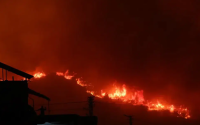9 January 2007Lewis Smith
Weather patterns that left Britain gasping for water during repeated bouts of prolonged drought at the start of the 20th century could be back in action, researchers fear.
The two unusually dry winters from 2004 to 2005 have alerted scientists to the possibility that cyclical patterns controlling droughts may be overwhelming the effects of global warming.
A study of droughts suggests that the weather of the past 50 years has been unusually kind and that prolonged dry periods would simply be a return to normal conditions.
Using analysis of historical weather patterns, the study shows that clusters of dry years, notably the Long Drought of 1890-1909, in the 19th and early 20th centuries were once a common feature of life in Britain.
There are signs now, despite recent heavy rainfall, that Britain could be reverting to the frequency of droughts seen in the past, bringing with them the threat of widespread restrictions on water use.
Water companies have been urged by scientists to prepare for the possibility of a series of dry winters that will guarantee summer droughts, just as the dry winters of 2004 and 2005 did last year. Winter rainfall is essential to water supplies throughout the year and dictates the level of supplies during the summer, when virtually all the rain evaporates.
Recent summers, notably last year when temperature records fell, are in line with climate change predictions, with rainfall being more than 10 per cent less than a century ago. Rainfall in winter, however, has failed to match expectations, with that of 2004-05 being among the driest for a century.
Even now, after four months of above average rain, water supplies are so low that 13 million people are still banned from using hosepipes.
Terry Marsh, who led the study, said: “The water industry has been alerted to the possibility that we could see drought patterns return to the sort of variability we’ve seen before. The surprise element is that most of us have grown up in a situation where winters have been relatively mild and wet, certainly in the past 30 years.”
Before the First World War drought was a constant threat. Between 1890 and 1909 a succession of dry years damaged agriculture and industry. The Times recorded in 1906 that milk production was severely hampered in Leicestershire and the Manchester area, while in 1899 water supplies were rationed to homes in Bradford to 9½ hours a day, “causing some inconvenience” with “farmers loudly calling out” for water.
Supplies to several cities in northern England were curtailed in 1868, when water had to be sent by train to Clitheroe, and 1887.
The authors of the report on droughts, expected to be published in the journal Weather in April, say in a draft version: “The historical record contains many examples of multi-year droughts. Such episodes were more common in the 19th century. The drought of 2004-06 is by no means exceptional.”
Mr Marsh, a senior hydrologer at the Centre for Ecology and Hydrology, said that it was important to look at weather records over centuries to help to identify cycles and provide clues as to what causes them.






